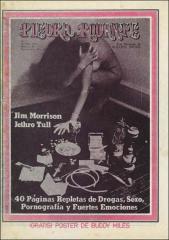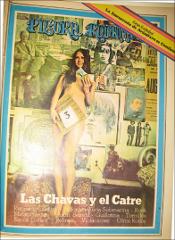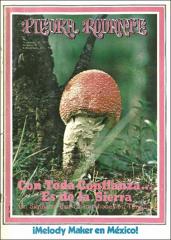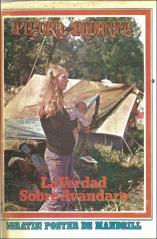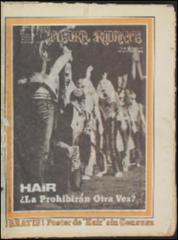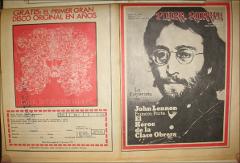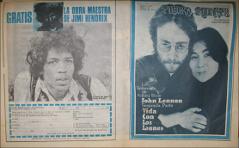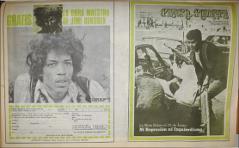Piedra Rodante Collection
Browse by
Collection Overview
Scroll down to see items.
Created and edited by Manuel Aceves, Piedra Rodante combined locally produced articles on music, politics, and the counterculture in Mexico with translated material from Rolling Stone magazine. The magazine was shut down by the Mexican government in early 1972 in a general crackdown on counterculture and political activity. Dr. Eric Zolov (Stony Brook University), who arranged the donation, has written about Piedra Rodante in his book Refried Elvis: The Rise of the Mexican Counterculture (University of California Press, 1999) and stated that “the magazine provides an essential portal into Mexican countercultural practices/discourse for the early 1970s.”
The period of Piedra Rodante’s relatively brief existence coincided with, and in turn helped to channel, the highpoint of Mexico’s rock counterculture. The roots of this countercultural movement date to the late 1950s and early 1960s when local bands, largely of middle- class origin, recorded direct copies in Spanish of foreign rock’n roll hits by singers such as Elvis Presley, Bill Haley, Paul Anka and the Everly Brothers. These Mexicanized cover versions of the imported originals were commonly referred to as refritos (as in, “refried songs”), and often had very inventive Spanish lyrics. By the mid 1960s scores of Mexican bands, largely concentrated in the capital but also cropping up in provincial cities, had laid the foundation for a vibrant, native rock scene to emerge. Mexico was not unique in this regard, although the Mexican scene was arguably one of the most significant. Across Latin America, from Guatemala to Argentina, dynamic rock’n roll movements catering to a burgeoning urban youth sector sprang up everywhere.
Mexican middle-class youth yearned to be recognized participants in the global counterculture. By around 1967, the cultural landscape of these youth reflected those yearnings, as expressed now not only through locally produced music but also through fashion, aesthetic choices, and a new youth argot. Collectively, this incipient countercultural movement was labeled within the media as “La Onda” (The Wave). Although intellectuals and more radical students generally regarded La Onda with a certain degree of disdain—judging it as “mere imitation” of a more authentic youth counterculture found abroad—in truth, the values and aesthetic choices linked to La Onda had seeped into all corners of youth cultural practice more broadly. This became especially apparent during the massive student-led demonstrations in the summer-fall of 1968, which culminated in a violent crackdown by the government on October 2 (“Massacre at Tlatelolco”). In the aftermath of the crackdown, La Onda was transformed by a generation of youth whose optimism had been shattered by the repression of a one-party state, into a vibrant vehicle for national protest.
In late 1970, Manuel Aceves, who was at the time working successfully in advertising, decided to give up his job and put together a magazine similar to Rolling Stone. Imitating Rolling Stone’s own take on the New York Times motto “all the news that’s fit to print,” by using “all the news that fits,” Aceves chose “el periódico de la vida emocional” (the newspaper of emotional life), meant as a pun on “el periódico de la vida nacional” (the newspaper of national life), which was the motto of Excélsior, one of Mexico’s two mayor newspapers at the time.
Aceves liked testing the boundaries of what could be published in Mexico, and Piedra Rodante’s reporting on the counterculture, as well as events and protests related to the regime crackdown after the Tlatelolco episode, soon reached a point the government of President Luis Echeverría (1970-76) was not willing to accept. After only eight issues, La Piedra, as it had become known, was abruptly shut down. Still, the magazine did manage to devote a whole issue to the 1971 Avándaro music festival, Mexico’s equivalent to Woodstock, and by then had become a vibrant forum for young writers interested in the new musical and cultural milieu of La Onda, at home and abroad.
Manuel Aceves secured permission at the time from Jann Wenner and Straight Arrow Publishers to use the material from Rolling Stone. The copyright owner for local materials is listed as Editores Tibales, S.A, which was a company created ad hoc by Aceves. After the magazine was closed down, Aceves did not pursue any other activities in that vein, and became an avid reader of the writings of the Swiss psychiatrist Carl Jung. Aceves died in 2009.
Stony Brook University Libraries has received a donation from Dr. Luis Gonzalez-Reimann (University of California, Berkeley) of the existing eight issues of the influential, short-lived Mexican periodical Piedra Rodante, for which he served as Associate Editor and Music Critic. The eight issues of this magazine are quite rare. There are only three libraries in the world that have any copies, and the two in the U.S.— Harvard and University of Texas at Austin—only have a couple of issues each. The rarity and the research value of the magazine set it apart from other publications of the period. On the importance of the donation, Dr. Gonzalez-Reimann said, “Considering that Stony Brook would make the issues available for scholarly purposes, I am convinced that, at this point (more than forty years later), Manuel Aceves would have been glad to allow the story and contents of Piedra Rodante to be widely known.”
Collection Overview authored in 2014 by:
- Dr. Eric Zolov, Stony Brook University
- Dr. Luis Gonzalez-Reimann (d. 2022), University of California, Berkeley

